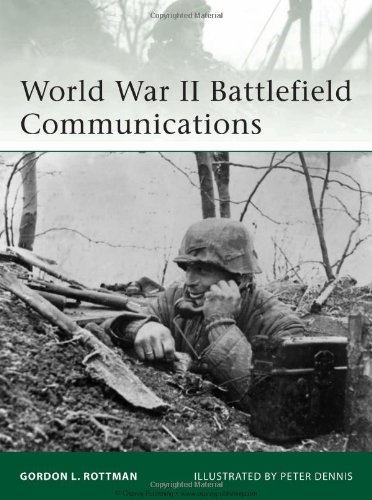World War II Battlefield Communications 1st Edition by Gordon L Rottman, Peter Dennis ISBN 1846038472 9781846038471 by Gordon L. Rottman 9781846038471, 9781849082853, 1846038472, 1849082855 instant download after payment.
World War II Battlefield Communications 1st Edition by Gordon L Rottman, Peter Dennis - Ebook PDF Instant Download/Delivery: 1846038472, 9781846038471
Full download World War II Battlefield Communications 1st Edition after payment

Product details:
ISBN 10: 1846038472
ISBN 13: 9781846038471
Author: Gordon L Rottman, Peter Dennis
World War II Battlefield Communications 1st Table of contents:
Part I: The Fundamentals and Early War Communications (1939-1941)
Chapter 1: The Pre-War Landscape of Military Communications
- 1.1 Legacy of World War I: Field Telephones, Runners, Flags
- 1.2 Interwar Development: The Rise of Radio and Voice Communications
- 1.3 Doctrine and Training in Major Powers (Germany, UK, USA, USSR, Japan)
- 1.4 The Concept of Command and Control in 1939
Chapter 2: Ground Force Communications
- 2.1 Wired Communications: Field Telephones, Telegraphs, and Cables
- Laying Cable Under Fire: Challenges and Techniques
- Switchboards and Exchange Operations
- Impact of Artillery and Sabotage
- 2.2 Runners, Messengers, and Visual Signals
- Despatch Riders and Their Role
- Flag Signals and Lamp Signaling
- 2.3 Early Backpack and Vehicle Radios
- Short-Range Infantry Radios (e.g., German "Torn.Fu.b1", British "Walkie-Talkie")
- Tank-to-Tank and Tank-to-Infantry Communications
- Limitations: Range, Weight, Power
Chapter 3: Air and Naval Communications
- 3.1 Aircraft Radios: Air-to-Air, Air-to-Ground, Navigation Beacons
- Voice Communication vs. Morse Code
- Interception and Jamming Challenges
- 3.2 Naval Communications: Ship-to-Ship, Ship-to-Shore
- Long-Range Radio Telegraphy
- Signaling Lamps and Flag Hoists
- The Importance of Naval Intelligence Gathering
Part II: The Evolution of Technologies and Doctrine (1942-1943)
Chapter 4: The Impact of New Radio Technologies
- 4.1 Miniaturization and Portability: The Rise of the Handheld Transceiver
- US SCR-536 "Handie-Talkie" and SCR-300 "Walkie-Talkie"
- British No. 18 and No. 38 Sets
- 4.2 Improved Vehicle-Mounted and Manpack Radios
- Increased Power and Range
- Crystal Control and Frequency Stability
- 4.3 Field Artillery and Air Support Communications
- Forward Air Controllers and Ground-to-Air Liaison
- Fire Control and Target Acquisition Networks
Chapter 5: Encrypting the Message: Code and Cipher Machines
- 5.1 The Fundamental Need for Security: Intercepting Enemy Communications
- 5.2 Mechanical Cipher Machines: Enigma, Lorenz, Typex, Hagelin
- Operating Procedures and Training
- Vulnerabilities and Operational Security
- 5.3 Codebooks and One-Time Pads
- 5.4 The Battle of Wits: Codebreaking vs. Cryptography
Chapter 6: Signals Intelligence and Counter-Communications
- 6.1 Radio Direction Finding (RDF) and Triangulation
- 6.2 Interception and Traffic Analysis
- 6.3 Jamming and Deception Operations
- 6.4 The Role of ULTRA, MAGIC, and Other Allied/Axis Codebreaking Efforts
- 6.5 Impact on Strategic and Tactical Decisions
Part III: Global Operations and Specialized Communications (1944-1945)
Chapter 7: Communications in Large-Scale Amphibious Operations (e.g., D-Day)
- 7.1 Coordination Challenges: Naval, Air, and Land Forces
- 7.2 Beachhead Communications and Establishing Networks
- 7.3 Communication Under Extreme Conditions and Enemy Fire
- 7.4 Lessons Learned from Major Landings
Chapter 8: Special Operations and Resistance Communications
- 8.1 Covert Radios: SOE S-Phones, OSS Radios
- 8.2 Burst Transmissions and Stealth Communications
- 8.3 Communication with Resistance Movements
- 8.4 Challenges: Detection, Security, and Operator Training
Chapter 9: Pacific Theater Communications
- 9.1 Unique Challenges: Vast Distances, Jungle Terrain, Climate
- 9.2 Amphibious Operations and Island Hopping Communications
- 9.3 Japanese Communications Doctrine and Equipment
- 9.4 US Marine Corps and Army Pacific Communications Adaptations
Chapter 10: Logistics, Maintenance, and Personnel
- 10.1 Supply Chains for Communication Equipment and Batteries
- 10.2 Field Repair and Maintenance Challenges
- 10.3 The Training and Deployment of Signal Corps Personnel
- 10.4 The Human Toll: Stress, Fatigue, and Casualties in Communications Units
Part IV: Legacy and Conclusion
Chapter 11: The Post-War Impact of WWII Communications
- 11.1 Innovations That Spurred Post-War Development
- 11.2 Influence on Cold War Communications Doctrine
- 11.3 Development of Commercial Radio and Electronics
- 11.4 The Lasting Legacy of Codebreaking and Signals Intelligence
Conclusion: The Invisible Threads of Victory
- Recapitulating the Pivotal Role of Communications in WWII
- The Evolution from Primitive to Sophisticated Networks
- The Human Element: Bravery, Ingenuity, and Sacrifice
- Unanswered Questions and Future Research
People also search for World War II Battlefield Communications 1st:
world war ii battlefield communications
battlefield communications ww1
world war ii battlefield
world war 2 communication
world war ii communications equipment
Tags: Gordon L Rottman, Peter Dennis, World War



